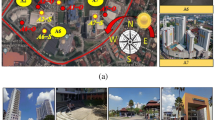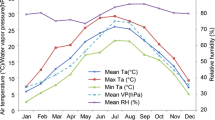Abstract
This study aims to evaluate agreement among subjective thermal comfort, thermal sensation, thermal perception, and thermal tolerance indices, according to pedestrians in downtown Santa Maria, southern Brazil, which has a humid subtropical climate (Cfa). Between August 2015 and July 2016 (three periods), 1728 questionnaires were applied. Evaluation of the dependence of statistical variables was based on gender and age, at three periods of time: August 2015 (864 respondents), January 2016 (432 respondents), and July 2016 (432 respondents). Statistical evaluation was based on Pearson’s chi-square test using RStudio software, and a significance level (α) of 5% for thermal comfort, thermal sensation, thermal preference, and thermal tolerance was used. Results indicated that age and gender affect the relationship between the variables. Thermal comfort and thermal tolerance presented the best correlation and coherence, regardless of age or gender. This study contributes to knowledge on the local microclimate and can contribute to urban planning to implement strategies that improve pedestrians’ thermal comfort.

Source: authors’ own

Source: Authors’ own

Source: Authors’ own

Source: Authors’ own
Similar content being viewed by others
References
ASHRAE (2005) ANSI/ASHRAE Guideline 2-2005 guide for engineering analysis for experimental data ASHRAE, Atlanta, GA, USA
ANSI/ASHRAE Standard 55R (2010) Thermal environmental conditions for human occupancy. American Society of Heating, Refrigerating and Air-Conditioning Engineers Inc. Atlanta
Baruti MM, Johansson E, Ǻstrand J (2019) Review of studies on outdoor thermal comfort in warm humid climates: challenges of informal urban fabric. Int J Biometeorol 63:1449–1462
Cheng NG et al (2010) Outdoor thermal comfort study in sub-tropical climate: a longitudinal study based in Hong Kong. Int J Biometeorol 47:4
Coccolo S et al (2018) Thermal comfort maps to estimate the impact of urban greening on the outdoor human comfort. Urban for Urban Green 35:91–105
Das M, Das A (2020) Exploring the pattern of outdoor thermal comfort (OTC) in a tropical planning region of eastern India during summer. Urban Clime 34:100708
De Dear R (2011) Revisiting an ol hypothesis of human thermal perception: alliesthesia. Build Res Inf 39(2)
Gobo JPA et al. (2008) O vento norte e os índices de violência doméstica em Santa Maria - RS. In: 8º Simpósio Brasileiro de Climatologia Geográfica. Anais. Alto Caparaó. Evolução Tecnológica e Climatologia
Gobo JPA et al (2017a) A influência do vento regional na sensação térmica de pedestres em espaços urbanos abertos: estudo de caso do vento norte em Santa Maria – RS. RAEGA (curitiba) 40:110–119
Gobo JPA et al (2017b) Avaliação da percepção climática de homens e mulheres e do conforto térmico em Santa Maria, RS. Boletim Paulista De Geografia 96:31–50
Gobo JPA et al (2018a) Empirical model of human thermal comfort in subtropical climates: a first approach to the Brazilian subtropical index (BSI). Atmosphere 9(10):391
Gobo JPA et al (2018b) Subjective human perception of open urban spaces in the Brazilian subtropical climate: a first approach. Climate 6(24):1–12
Gobo JPA et al (2018c) Calibração das faixas de conforto térmico humano para espaços abertos em clima subtropical. Revista do Departamento de Geografia, volume especial do II Workshop do Programa de Pós-Graduação em Geografia Física
Gobo JPA et al (2019) Empirical model of thermal comfort for medium-sized cities in subtropical climate. Atmosphere 10(576):1–18
Hasebe Y, Iriki M, Takahasi K (1995) Usefulness of R-R interval and its variability in evaluation of thermal comfort. Int J Biometeorol 38:116–121
Heng SL, Chow WTL (2019) How ‘hot’ is too hot? Evaluating acceptable outdoor thermal comfort ranges in an equatorial urban park. Int J Biometeorol 63:801–816
Hirashima SQS, Katzschner A, Ferreira DG, Assis ES, Katzschner L (2018) Thermal comfort comparison and evaluation in different climates. Urban Clim 23:219–230
Instituto Brasileiro de Geografia e Estatística – IBGE (2021) População estimada. IBGE, Diretoria de Pesquisas, Coordenação de População e Indicadores Sociais, Estimativas da população residente com data de referência 1º de julho de 2021. Rio de Janeiro, vol 16
Instituto Nacional de Meteorologia – INMET (2023) Available in http://www.inmet.gov.br. Accessed 13 July 2023
International Organization for Standardization – ISO (1995) ISO 10551: Ergonomics of the thermal environment – Assessment of the influence of the thermal environment using subjective judgement scales. Geneva
International Organization for Standardization – ISO (2005) ISO 7730: Ergonomics of the thermal environment – Analytical determination and interpretation of thermal comfort using calculation of the PMV and PPD indices and local thermal comfort criteria. Geneva
Jamei E, Tapper N (2019) WSUD and urban heat island effect mitigation. Approaches Water Sensit Urban Des, pp 381–407
Kingma BRM, Schellen L, Frijns AJH, Lichtenbelt WD (2012) Thermal sensation: a mathematical model based on neurophysiology. Indoor Air 22:253–262
Knez I, Thorsson S (2006) Influences of culture and environmental attitude on thermal, emotional and perceptual evaluations of a public square. Int J Biometeorol 50:258–268
Knez I, Thorsson S (2008) Thermal, emotional and perceptual evaluations of a park: cross-cultural and environmental attitude comparisons. Build Environ 43:1483–1490
Krüger EL, Drach PRC (2016) Impactos do uso de climatização artificial na percepção térmica em espaços abertos no centro do Rio de Janeiro. Ambiente Construído, Porto Alegre 17(1):133–148
Krüger E, Rossi F, Drach P (2017) Calibration of the physiological equivalent temperature index for three different climatic regions. Int J Biometeorol 61:1323–1336
Kumar P, Sharma A (2020) Study on importance, procedure, and scope of outdoor thermal comfort – a review. Sustain Cities Soc 61:102297
Lam CKC et al (2020) Interactive effect between long-term and short-term thermal history on outdoor thermal comfort: comparison between Guangzhou, Zhuhai and Melbourne. Sci Total Environ 760:144141
Lopes HS, Remoaldo PC, Ribeiro V, Martín-Vide J (2021) Perceptions of human thermal comfort in an urban tourism destination – a case study of Porto (Portugal). Build Environ 205:108246
Ma X, Tian Y, Du M, Hong B, Lin B (2021) How to design comfortable open spaces for the elderly? Implication of their thermal perceptions in an urban park. Sci Total Environ 768:1–20
Martini A et al (2014) Percepção da população sobre o conforto térmico proporcionado pela arborização de ruas de Curitiba – PR. Floresta 44(3):515–524
Monteiro LM (2008) Modelos preditivos de conforto térmico: Quantificação de relações entre variáveis microclimáticas e de sensação térmica para avaliação e projeto de espaços abertos. 378 f. Tese (Doutorado em Arquitetura e Urbanismo) – Universidade de São Paulo, São Paulo
Nikolopoulou M, Baker N, Steemers K (2001) Thermal comfort in outdoor urban spaces: understanding the human parameter. Sol Energy 70(3):227–235
Oke TR (1987) Boundary layer climates, 2nd edn. Methuen Publishers, Lagos
Oke TR (2004) Initial guidance to obtain representative meteorological observations at urban sites. IOM Rep. 81, WMO/TD-No. 1250. Geneva: World Meteorological Organization
Pantavou K et al (2013) Outdoor thermal sensation in a Mediterranean climate and a comparison with UTCI. Build Environ 66:82–95
Potchter O, Cohen P, Lin T-P, Matzarakis A (2018) Outdoor human thermal perception in various climates: a comprehensive review of approaches, methods and quantification. Sci Total Environ 631–632:390–406
Rossato PS (2011) O sistema termodinâmico do clima urbano de Nova Palma, RS: contribuição ao clima urbano de cidades pequenas. Dissertação (Mestrado em Geografia) - Universidade Federal de Santa Maria, Santa Maria - RS
Ruiz MA, Correa EN (2015) Suitability of different comfort indices for the prediction of thermal conditions in tree-covered outdoor spaces in arid cities. Theor Appl Climatol 122:69–83
Sartori MGB (2000) Clima e percepção. Tese (Doutorado) – Faculdade de Filosofia, Letras e Ciências Humanas, USP, São Paulo
Stone B (2012) The city and the coming climate: climate change in the places we live. Cambridge University Press, New York
Tung C-H, Chen C-P, Tsai K-T, Kántor N, Hwang R-L, Matzarakis A, Lin T-P (2014) Outdoor thermal comfort characteristics in the hot and humid region from a gender perspective. Int J Biometeorol 58:1.927-1.939
Velt KB, Daanen HAM (2017) Thermal sensation and thermal comfort in changing environments. J Build Eng 10:42–46
Xi T et al (2012) Study on the outdoor thermal environment and thermal comfort around campus clusters in subtropical urban areas. Build Environ 52:162–170
Yang W, Wong NH, Jusuf SK (2013) Thermal comfort in outdoor urban spaces in Singapore. Build Environ 59:426–435
Yang L, Zhao S, Gao S, Zhang H, Arens E, Zhai Y (2021) Gender differences in metabolic rates and thermal comfort in sedentary young males and females at Various Temperatures. Energy Build 251:111360
Zhao L, Zhou X, Li L, He S, Chen R (2016) Study on outdoor thermal comfort on a campus in a subtropical urban area in summer. Sustain Cities Soc 22:164–170
Author information
Authors and Affiliations
Corresponding author
Rights and permissions
Springer Nature or its licensor (e.g. a society or other partner) holds exclusive rights to this article under a publishing agreement with the author(s) or other rightsholder(s); author self-archiving of the accepted manuscript version of this article is solely governed by the terms of such publishing agreement and applicable law.
About this article
Cite this article
da Silva Dávila, J., de Campos Grigoletti, G., Faria, M.R. et al. The thermal comfort of pedestrians in a humid subtropical climate according to different thermal perception ratings. Int J Biometeorol 68, 675–690 (2024). https://doi.org/10.1007/s00484-023-02614-0
Received:
Revised:
Accepted:
Published:
Issue Date:
DOI: https://doi.org/10.1007/s00484-023-02614-0





